Some daily events in the changing sky for May 9 – 17.
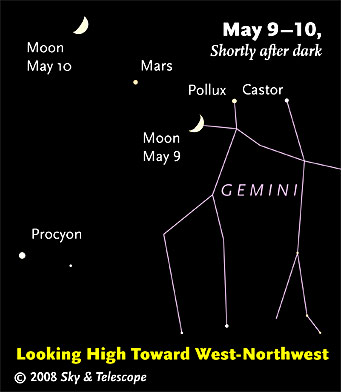
On Friday and Saturday nights, the Moon, thicker now, joins the Mars-Pollux-Castor lineup. (These scenes are drawn for the middle of North America. European observers: move each Moon symbol a quarter of the way toward the one for the previous date.)
"="right
Friday, May 9
Saturday, May 10
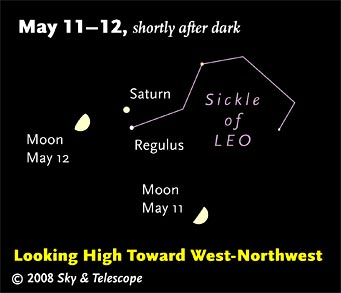
On Sunday and Monday the Moon passes Saturn and Regulus. (Moon positions are for the middle of North America. Europeans: move each Moon symbol a quarter of the way to the one for the previous date.)
Sky & Telescope diagram
Sunday, May 11
Monday, May 12
Tuesday, May 13
Wednesday, May 14
Then look two thirds of the way from Arcturus to Vega for the Keystone of Hercules, highlighted by nothing at all.
Thursday, May 15
Friday, May 16
Saturday, May 17
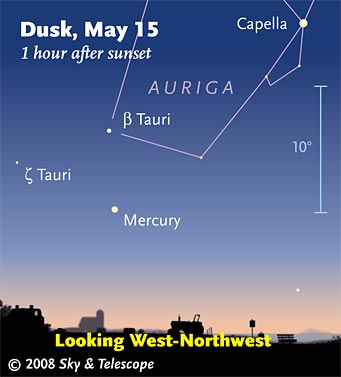
If you have trouble spotting Mercury this week, look for Capella higher up and scan lower left from there. (This scene is drawn for 40° north latitude. The blue "10°" scale is about the size of your fist held at arm's length.)
Sky & Telescope diagram
Want to become a better amateur astronomer? Learn your way around the constellations. They're the key to locating everything fainter and deeper to hunt with binoculars or a telescope. For an easy-to-use constellation guide covering the whole evening sky, use the big monthly foldout map in each issue of Sky & Telescope, the essential magazine of astronomy. Or download our free Getting Started in Astronomy booklet (which only has bimonthly maps).
Once you get a telescope, to put it to good use you'll need a detailed, large-scale sky atlas (set of maps; the standards are Sky Atlas 2000.0 or the smaller Pocket Sky Atlas) and good deep-sky guidebooks (such as Sky Atlas 2000.0 Companion by Strong and Sinnott, the even more detailed Night Sky Observer's Guide by Kepple and Sanner, or the enchanting though increasingly dated Burnham's Celestial Handbook). Read how to use them effectively.
More beginners' tips: "How to Start Right in Astronomy".
This Week's Planet Roundup
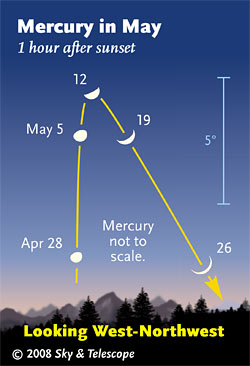
Shown here are Mercury's positions 1 hour after sunset (as seen from latitude 40° north) all through May. Its phase as seen in a telescope is shown on various dates. (The blue 5° scale, for judging height above the horizon, is about half the width of your fist at arm's length.)
S&T Illustration
Mercury is still in its highest evening apparition of the year (for skywatchers at mid-northern latitudes). Look for it fairly low in the west-northwest as twilight deepens. But Mercury is fading now, from magnitude –0.1 on May 9th to +0.8 on the 17th. See our article.
Venus is hidden in the glare of the Sun, and will stay so for months to come.
Mars (magnitude +1.3, in Cancer) shines high in the west after dark, to the upper left of the Castor-and-Pollux pair. Each week, Mars is moving farther away from them and closer to the Saturn-and-Regulus couple, which is still well off to Mars's upper left. Mars will meet up with them in early July.
In a telescope Mars is a minuscule 5.4 arcseconds wide. Don't bother.
Jupiter (magnitude –2.5, in eastern Sagittarius) rises around midnight or 1 a.m. daylight saving time. By dawn it's glaring at its highest and best in the south. (The table of Jupiter's satellite phenomena in the May Sky & Telescope is incorrect; use our corrected version.)
Saturn (magnitude +0.6, in Leo) glows high in the southwest after dark, just 2¼° from fainter Regulus (magnitude +1.4). They're quite the eye-catching couple. They will remain nearly this close all May.
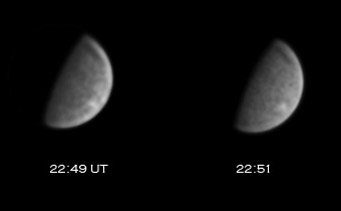
To your eyeball, a telescope is doing well if it just shows Mercury's phase clearly. Centuries of astronomers couldn't distinguish surface markings reliably enough to find the planet's correct rotation period. But infrared imaging and video-frame stacking have brought Mercurian surface features in range of amateurs. Sean Walker used a 12.5-inch reflector in broad daylight to take these infrared images on May 5, 2008, about an hour before sunset. The times are in Universal Time.
S&T: Sean Walker
Telescope users: can you see the pair of white storms on Saturn? How big a telescope do you need? To predict when they'll be turned into view (which happens at least twice a day), see the picture caption at the bottom of this page.
There's more to Saturn than you may realize! See our Saturn observing guide in the April Sky & Telescope, page 66.
Uranus and Neptune (magnitudes 6 and 8, respectively, in Aquarius and Capricornus) are still low in the east and southeast before dawn.
Pluto (magnitude 14.0, in northwestern Sagittarius) is highest in the south before dawn's first light. If you've got a big scope and ambition to match, see our article and finder chart.
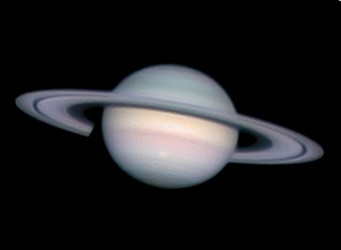
A white storm is visible in Saturn's South Temperate Zone — and since this picture was taken, it has divided into two! The original storm shows plainly in this stacked-video image taken by Sean Walker through a 12.5-inch reflector at 0:42 UT April 23rd during excellent seeing. "The white spot was visible in an eyepiece at over 500x, particularly through a green filter," Walker writes. North is up.
To find when the white spots are in view: For your date, look up Saturn's System II central-meridian longitude in this table (it's the "CMII" column). That's the value for 0:00 Universal Time (UT or GMT) on your date. To this value, add 33.8° for each whole hour since 0:00 UT, and 0.56° for each minute, for the time you plan to observe. See what you get. Find a good Saturn-observing time and date for you that results in something around 75°, and plan to be out then with your scope.
P.S.: Here's an incredible closeup shot of the storm by Cassini taken on March 4th. Cassini's radio instruments find that the storm is full of lightning.
S&T: Sean Walker
All descriptions that relate to your horizon or zenith — including the words up, down, right, and left — are written for the world's mid-northern latitudes. Descriptions that also depend on longitude (mainly Moon positions) are for North America. Eastern Daylight Time (EDT) equals Universal Time (UT, UTC, or GMT) minus 4 hours.
"Rational and innocent entertainment of the highest kind."
— John Mills, 19th century Scottish manufacturer and founder of Mills Observatory, on amateur astronomy.
----------------------
If pictures fail to load, refresh the page. If they still fail to load, change the 1 at the end of the URL to any other character and try again.
 0
0
Comments
You must be logged in to post a comment.